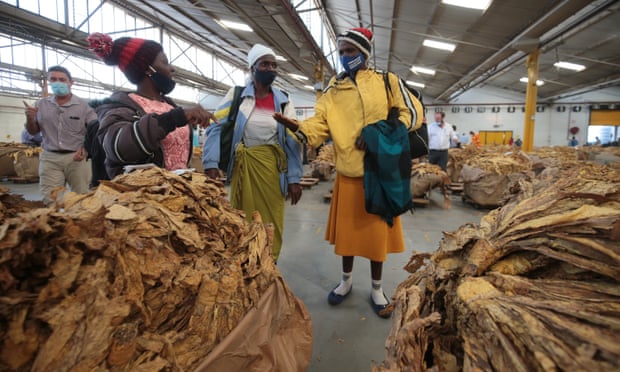Tobacco farmers in conversation during the start of the 2021 marketing season in Harare. Picture credit: Aaron Ufumeli/EPA
CLAIM: White farmers are mostly responsible for Zimbabwe’s rebounding farm output.
Source: Bloomberg News
VERDICT: Incorrect. Available data shows that communal farmers, who have traditionally produced most of Zimbabwe’s staple maize, remain the leading producer of the grain and now also account for most of the tobacco output. Communal farmers are also significant producers of soyabean, accounting for nearly half the output.
Bloomberg News, in an article headlined “Zimbabwe’s farming booms masks 20 years of failure”, claimed that:
“Two decades after Robert Mugabe drove white farmers off their land, Zimbabwe’s agricultural sector is booming. The people tending the crops are, again, mostly white farmers.”
The article also further claims: “Zimbabwean farming is dominated by large companies such as British American Tobacco and Innscor Africa that hire growers to produce on their behalf on a commercial scale.”
What does the data say?
MAIZE
This is Zimbabwe’s staple grain. Maize production from the 2020/21 season was reported to be 2,7 million tonnes, the highest since 1984.
Official statistics show that communal farmers, who have traditionally produced the bulk of Zimbabwe’s maize, had the largest sectoral output, at 988 782 tonnes. This was followed by the sector commonly known as the A1 segment, made up of communal farmers resettled on 6 hectare plots since the onset of the government’s land redistribution drive in 2000. The A1 farmers produced 706 372 tonnes of maize in the 2020/21 season. Combined, the communal and A1 farmers, segments that are overwhelmingly black dominated, produced 62% of Zimbabwe’s maize in the last farming season. The trend was the same in 2019/20, when communal and A1 farmers produced a combined 511 000 tonnes, or 56% of the total 908 000 tonne output for that season. Communal and A1 farmers’ contribution to maize production was 58% and 56% in the 2017/18 and 2018/19 seasons, respectively.
| Sector | Production (MT)/ (% Contribution) | Production (MT)/ (% Contribution) | Production (MT)/ (% Contribution) | Production (MT)/ (% Contribution) |
| 2017/18 | 2018/19 | 2019/20 | 2020/21 | |
| Communal | 540 939 (31.8%) | 251 576 (32%) | 291 867 (32%) | 988 782 (36.4%) |
| Old Resettlement | 136 973 (8%) | 69 022 (9%) | 88 384 (10%) | 232 995 (8.57%) |
| Small Scale Commercial | 46 852 (2.8%) | 23 640 (3%) | 27 235 (3%) | 102 710 (3.78%) |
| Communal Resettlement (A1) | 434 949 (25.6%) | 187 504 (24%) | 219 055 (24%) | 706 372 (25.99%) |
| Commercial Resettlement (A2) | 527 556 (31%) | 239 108 (31%) | 275 318 (30%) | 670 785 (24.69%) |
| Peri-urban | 13 433 (0.8%) | 5 785 (1%) | 5 768 (1%) | 15 526 (0.57%) |
| TOTAL | 1 700 702 | 776 635 | 907 628 | 2 717 171 |
The data shows that black farmers have accounted for at least 58% of Zimbabwe’s maize production. The contribution is higher, as this statistic does not include the output from black farmers in the commercial sector, whose data could not be disaggregated. It is incorrect to credit white farmers with “tending most of the maize crop”, as claimed by the Bloomberg article.
TOBACCO
Production of Zimbabwe’s leading export crop, tobacco, plunged to a record low of 48 million kilogrammes in 2008, down from the previous peak of 237 million kg in 2000, the last crop before farm disruptions brought about by land redistributions.
Tobacco production has since rebounded, with a new production record of 259 million kg being recorded in 2019.
The latest available data from the Tobacco Industry and Marketing Board (TIMB) shows that communal farmers contributed the most to tobacco production in 2018 (with 87 million kg or 34%), followed by the resettled commercial (A2) sector, which produced 74 million kg or 29%. Resettled communal farmers accounted for 71 million kg or 28%.
Combined, communal farmers contributed 62% to Zimbabwe’s 2018 tobacco output.
In 2017, resettled commercial (A2) farmers contributed the most tobacco (62 million kg or 33%), but the two communal farmer segments accounted for a combined 52% of output.
| Sector | Production (kg) | Production (kg) | Production (kg) | Production (kg) |
| 2015 | 2016 | 2017 | 2018 | |
| Resettled communal (A1) | 51,283,419 | 50,877,853 | 51,780,583 | 71,251,736 |
| Resettled Commercial (A2) | 70,892,762 | 79,274,099 | 61,873,538 | 73,795,590 |
| Communal | 57,290,484 | 52,559,259 | 58,412,874 | 86,827,243 |
| Small Scale Commercial | 19,867,426 | 19,573,383 | 16,853,323 | 20,728,683 |
| TOTAL | 198,954,849 | 202,284,589 | 188,920,318 | 252,603,251 |
WHEAT
Zimbabwe is set to harvest 300 000 tonnes of wheat this year, according to a Cabinet statement of 21 September 2021. This would be the highest wheat production since 1999, when 324 000 tonnes were harvested.
Wheat production, which is capital intensive, requiring mechanisation and irrigation, is almost entirely a preserve of commercial farmers.
While disaggregated data for wheat production by sector was not immediately available, a Cabinet statement of 22 June 2021 said the government, directly and in collaboration with CBZ Agro Yield had financed 75% of the wheat crop. The private sector funded the balance.
SOYA BEAN
The area under soya bean has declined from 60 650 hectares in 1999/2000, to 46 158 hectares in 2020/21, according to Zimstat data.
Production has also declined, from 135 417 tonnes in 1999/2000 to 71 290 tonnes in 2020/21. Zimbabwe still imports huge quantities of soya bean, due to low levels of production.
A study by the Zimbabwe Economic Policy and Research Unit (Zeparu) showed that, in 2000, predominantly white large scale commercial farmers produced 98% of the country’s soya bean. By 2015, large scale commercial farms accounted for just under 9% of production.
In 2015, resettled commercial farmers (A2), had the largest share of production, accounting for 45%. In second place was the resettled communal farm sector, which contributed 38%. Communal farmers contributed to 6% of the production.
CONCLUSION:
Bloomberg’s assertion, which credits white farmers for Zimbabwe’s “booming” agriculture sector, is not supported by the available evidence. Data shows that communal farmers, who are predominantly black, are producing the bulk of Zimbabwe’s maize and tobacco. Communal farmers are also producing nearly half the soybean crop. Black commercial farmers, with the assistance of government funding programmes are also contributing significantly to wheat production.
Do you want to use our content? Click Here












